
It rises as the most massive, modern edifice near the great Acropolis of Athens. Located only 280 meters from the Parthenon itself, near the southeastern slope of the iconic rock, it strikes an imposing and contrasting contemporary presence among surrounding structures that represent an earlier time in Athen’s history. Opened to the public in 2009, the Acropolis Museum houses more than 4,250 artifacts and other objects, many of which are exhibited across an internal area of 14,000 square meters. Entering and walking throughout this magnificent space, what profoundly strikes most visitors is the statuary, removed from their original Acropolis locations through time as archaeologists, conservationists and others have worked at the famous summit and the associated ancient remains that still grace much of its slope.
______________________________

The Acropolis Museum as seen from the top of the Acropolis hill. Louis Dalibard, Creative Commons Attribution-Share Alike 4.0 International, Wikimedia Commons
______________________________

The Acropolis as seen from the Acropolis Museum.
______________________________
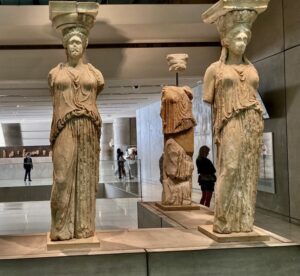
As exhibited in the Acropolis Museum: Original caryatids from the Acropolis hill.
______________________________
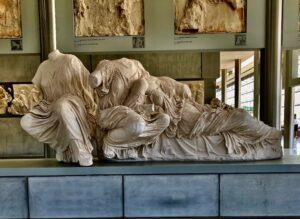
Above and below: Original statuary from the frieze that once graced the front of the Parthenon, as exhibited in the Acropolis Museum.
______________________________

______________________________
But there is a ‘secret’ to this museum that most visitors don’t know or think about until they actually step upon the museum floors. It lies below the surface. Like viewing through a looking glass, you can see it by peering down through filmy, transparent rectangular sections embedded into the floor, interspersed throughout the museum’s ground floor space. Here you see the remains of ancient structures unearthed through a series of excavations in the area at a site designated by archaeologists as the “Makrygiannis plot”, an urban neighborhood that flourished for centuries in the shadow of the Acropolis.
______________________________
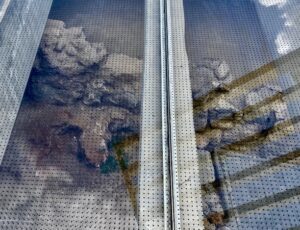
The archaeological remains as seen through the floor of the Acropolis Museum.
______________________________
A Slice of Urban Life in Antiquity
From the 4th century BC to the 12th century AD, people carried out their daily lives in this place. They constructed streets, residences, baths, workshops and tombs. Today, visitors can see only a small part of the entire settlement, the segment that has been exposed intact beneath the new Acropolis Museum construction and the Acropolis Metro Station. The rest has been covered with earth during investigations and excavations, preserved and protected for the future.
What the observer sees today are mostly the better-preserved remains dating from Late Antiquity. Prominent among them are the remains of a luxurious residential mansion complex that included colonnaded courtyards, mosaic floors, a private bath system and latrines. Archaeologists and historians suggest that the residence belonged to a wealthy high-ranking official or local patron with ties to Rome’s imperial court. Other elements of the excavated area include public latrines and private baths, such as the West Bath, of other wealthy citizens.
_________________________________
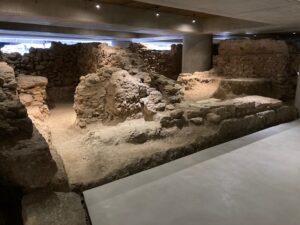
Remains of the ancient community beneath the museum can today be freely viewed with admission to the Acropolis Museum.
_________________________________
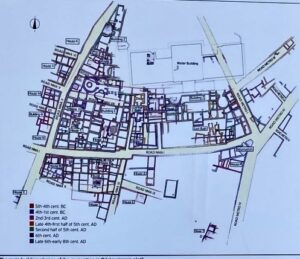
Map of the ancient community. As exhibited at the Acropolis Museum.
______________________________
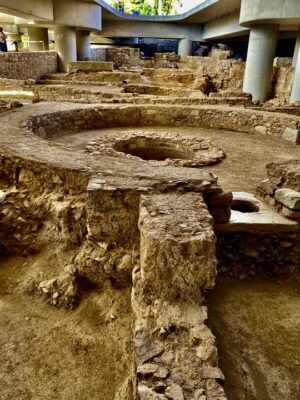
Above and below: The remains of a magnificent residence of a wealthy individual, as shown among the remains of the excavated community.
______________________________
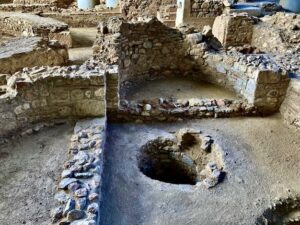
______________________________

______________________________
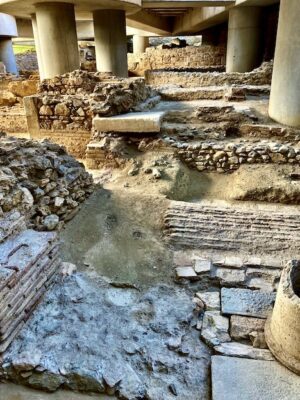
______________________________
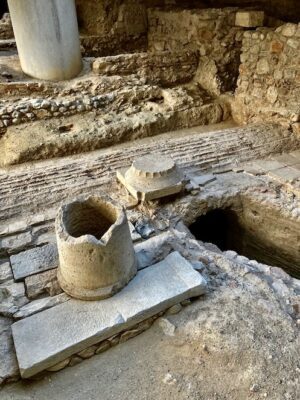
______________________________
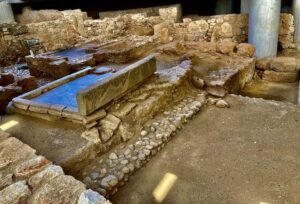
Above and below (drawing), the remains of a private bath house as part of a wealthy residence. Both photos are details of exhibits displayed at the Acropolis Museum.
______________________________
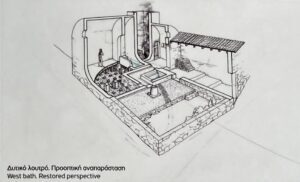
______________________________
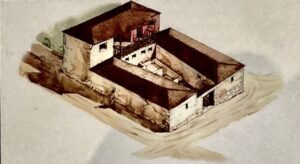
Below: Remains of one of the oldest elite houses of the excavation. This residence was founded in the late 5th century B.C., and was in use until the 6th century A.D. Seen here (below) are mostly the remains of the 5th and 3rd centuries B.C., as well as some remains representing the 6th century A.D.
Notable are remains from the 3rd century B.C., showing a house courtyard where later a workshop was constructed. It features three cisterns, with a terracotta cylindrical pipeline providing fresh water and another pipeline diverting water to the street’s sewer. It is hypothesized that the workshop was a fullonica, where dirty clothes were washed and processed/whitened before being colored. The above illustration detail of artist’s rendition of the house is shown as exhibited at the Acropolis Museum.
______________________________

______________________________
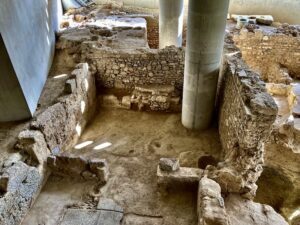
______________________________

______________________________

______________________________
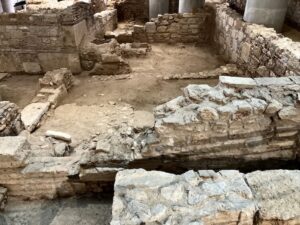
______________________________
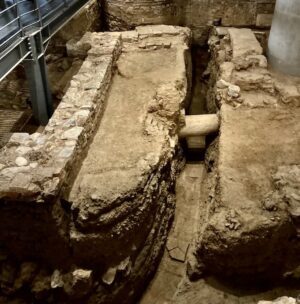
______________________________
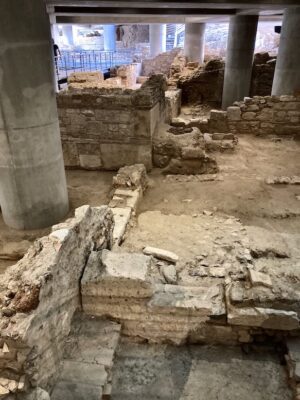
______________________________
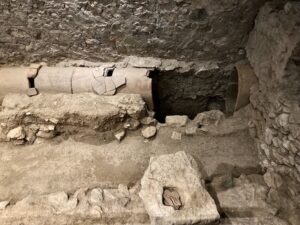
______________________________

______________________________
Not the least in terms of significance, the excavations have yielded numerous artifacts, including sculptures, various types of vessels, and coins, among other finds. These artifacts have helped to shed great light on our knowledge of the life-ways of the inhabitants over centuries of occupation.
_______________________________
For interested readers, this site and many more are best visited in person. See the website to get your journey started.
______________________________
Advertisement

EXPLORE THE ANCIENT ETRUSCANS IN PERSON!
Experience a unique, up-close-and-personal hike among ancient hilltop towns in central Italy. You will walk the sensational countryside of the regions of Umbria and Tuscany, soaking in important sites attesting to the advanced Etruscan civilization, forerunners of the ancient Romans; imposing architectural and cultural remains of Medieval Italy; local food and drink; and perhaps best of all — spectacular scenic views! Join us in this collaborative event for the trip of a lifetime!
______________________________


